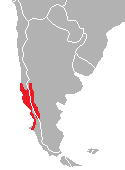Southern pudu
| Southern pudu | |
|---|---|

| |
| Southern pudu (P. puda) | |
| Scientific classification | |
| Domain: | Eukaryota |
| Kingdom: | Animalia |
| Phylum: | Chordata |
| Class: | Mammalia |
| Order: | Artiodactyla |
| Family: | Cervidae |
| Subfamily: | Capreolinae |
| Genus: | Pudu |
| Species: | P. puda
|
| Binomial name | |
| Pudu puda (Molina, 1782)
| |

| |
| Geographic range of Pudu puda | |
| Synonyms | |
|
Capra puda Molina, 1782[3] | |
The southern pudu (Pudu puda,
Description
The southern pudu is characterized by being the second smallest deer in the world. It is slightly larger than its sister species, the northern pudu, being 35 to 45 cm (14 to 18 in) tall at the shoulder and weighs 6.4 to 13.4 kg (14 to 30 lb). The antlers of the southern pudu grow to be 5.3 to 9 cm (2.1 to 3.5 in) long and tend to curve back, somewhat like a mountain goat. Its coat is a dark chestnut-brown, and tends to tuft in the front, covering the antlers.[5]
Range and habitat
The southern pudu lives in forests, including both mature and disturbed forests, typically with a dense understory, but it does nevertheless prefer open spaces with rich vegetation for feeding.
Foraging by southern pudu is thought to be detrimental for the regeneration of burned forests of
Genetic diversity
Analysis of the mtDNA control region and cytochrome b of the southern pudu across Chile revealed that different populations have marked genetic differences, with a large number of unique haplotypes in each population and few shared haplotypes between populations. This indicates that gene flow is reduced and most populations are reproductively isolated from each other.[7] The population from Chiloé Island is estimated to have become isolated from continental populations more than 200 thousand years ago and may constitute a separate subspecies.[8] This reproductive isolation makes each population an important evolutionary unit but also increases their vulnerability since a drastic reduction in the number of individuals would decrease genetic diversity without recovery from migrating individuals coming from neighboring areas.[7]
Further reading
- Colihueque, Nelson; Arriagada, Aldo; Fuentes, Andrea (2020). "Distribution modelling of the Pudu deer (Pudu puda) in southern Chile". Nature Conservation. 41: 47–69. .
- Molina, J. Ignatius (1809). The Geographical, Natural, and Civil History of Chili. Longman. p. 256.
References
- ^ . Retrieved 24 April 2023.
- ^ "Appendices | CITES". cites.org. Retrieved 2022-01-14.
- ^ Molina, Giovanni Ignazio (1782). "Il Pudu, Capra Puda". Saggio sulla storia naturale del Chili. Bologna: S. Tommaso d'Aquino. pp. 308–309.
- ISBN 956-8287-99-X.
- ^ "Forest South America". Animal Welfare Institute. Archived from the original on 2009-02-18. Retrieved 20 September 2009.
- ^ S2CID 202853005.
- ^ S2CID 249933031.

- S2CID 85158582.

